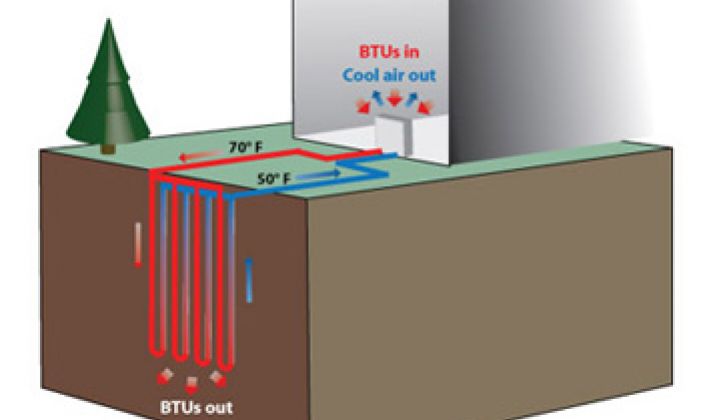The recent success of solar PV has nothing to do with the sun shining brighter. Instead, the uptake in solar is largely due to falling technology costs and new financing schemes that don’t rely on homeowners or businesses to shell out cash upfront for an entire system.
Solar models are now informing other renewable energy technologies, namely, geothermal heat pumps. Unlike geothermal power plants, which involve deep drilling to access naturally occurring reservoirs of hot water, geothermal heat pumps sit far closer to the surface and provide heating, cooling and hot water at a fraction of the cost of conventional systems. Despite the incredible resources for different geothermal technologies in the U.S., these vast resources remain largely untapped for many reasons.
The upfront cost of a closed-loop geothermal heat pump, which involves installing a series of liquid-filled underground pipes, has kept the technology on the sidelines. In Colorado, that could become a problem of the past. PanTerra Energy has become the first private company to be registered with the Public Utility Commission as a geothermal utility in Colorado.
“If you were installing gas, the gas utility would bring the gas line to your facility, then you’d pay for access to it,” said Mike Ryan, president and co-founder of PanTerra Energy. His company does not claim any technological improvement on the closed-loop systems that are already out there, but it is offering a scheme similar to a power purchase agreement that allows institutions to get geothermal without shelling out the millions of dollars to build the system, because PanTerra owns and operates the infrastructure.
“If you can provide users with a straightforward monthly cost for their heating and cooling, without the added financial burden of buying the loop field infrastructure, then GHPs can quickly become a mainstream technology," Ben Northcutt, executive director of the Colorado Geo Energy & Heat Pump Association, said in a statement.
Closed-loop systems sit dozens -- not hundreds -- of feet below the surface. At that depth, the earth’s temperature is fairly constant (about 55 degrees Fahrenheit) so that air from the surface can be moved through to warm it in winter or cool it in summer. (The steady temperatures can be as few as 10 feet under our feet.) A geothermal heat pump passes the air below the surface and uses 25 percent to 70 percent less energy than conventional heating and cooling, according to PanTerra Energy.
Installing the system of pipes below the ground isn’t unheard of; there are installations in all 50 states. Ryan said, “Geothermal has been used for decades and has been successfully used in schools, jails and commercial structures.” Ball State University in Indiana, for instance, has the nation’s largest ground-source, closed-loop geothermal system, which will supply heat and cooling to 47 buildings on campus when it’s complete. The university will be able to shut down four coal-fired boilers.
Even though geothermal heat pumps aren’t new, the way the industry is designed has made it difficult for prices to come down. PanTerra assembled the disparate parts of the geothermal ecosystem in one place, combining drilling, installation and financing. The Englewood, Colo.-based company, which just launched last year, is in talks with towns, counties, universities and correctional facilities. The technology can be used in residential applications, but for now the focus is on commercial and municipal applications.
Colorado has had a statute on the books since the 1980s stating that a geothermal company could be treated as a utility, but it was a chicken-and-egg proposition, as the company needed to already have had completed a project that’s been defined as such in order to receive the designation. Of course, no project would get green-lighted without Public Utility Commission (PUC) approval.
PanTerra worked through the process by coming to an agreement with the PUC to get a preliminary registration to go forward and land projects that can then be permitted by the PUC.
Although the first contract has yet to be inked, there is already interest from other states, including California and Rhode Island.
If PanTerra is successful in landing customers and managing geothermal systems as the first geothermal utility, it will hardly offset existing utilities. Traditional utilities still need to keep the lights on and power the electrical outlets. If anything, geothermal utilities could be a benefit to utilities, as there are no air-conditioning peaks with geothermal the way there is with traditional AC.
Even if the technology isn’t new or disruptive, it doesn’t mean there isn’t a lot of work still to do. “The PUC has been very receptive,” said Ryan. “But when you’re the first one that’s doing this, you are in some ways creating the wheel.”



